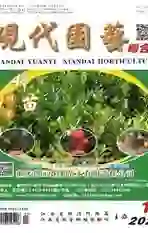主要蔬菜作物基因定位与分子辅助选择育种
2020-03-08刘子记牛玉刘维侠杨衍
刘子记 牛玉 刘维侠 杨衍
摘要:随着分子生物学的快速发展,主要蔬菜作物的分子育种研究取得了快速进展。综述了主要蔬莱作物分子遗传图语构建、基因定位和分子辅助选择等方面取得的进展,分析了現阶段蔬莱作物分子辅助选择存在的问题,初步探讨了未来分子辅助育种的发展策略。
关键词:蔬菜;遗传图谱;农艺性状;基因定位;分子辅助选择
遗传连锁图谱的构建是基因定位和分子辅助育种于细胞核雄性不育、枯萎病抗性等性状的辅助选择。的前提。分子标记辅助育种实现了由表型选择到基因型选择的转变,在选择效率和精度上较传统育种具有很强的优势。截至目前,分子标记在十字花科(白菜和甘蓝)、葫芦科(黄瓜、南瓜、苦瓜)、茄科(番茄、辣椒、马铃薯、茄子)等主要蔬菜作物中开展了大量研究,构建了多幅高密度的分子标记连锁图谱,定位了一大批重要基因,为开展分子标记辅助育种奠定了重要基础。
1 十字花科主要蔬菜作物基因定位与分子辅助选择
1991年,Song等[1]主要基于RFLP标记构建了首幅白菜遗传图谱。截至目前,20余幅白菜遗传图谱相继被构建,自交不亲和性基因、抗根肿病基因、抗黑腐病基因、抗芜菁花叶病毒病基因、抽薹开花和春化基因、育性相关基因、种皮颜色基因、耐热性基因、开花相关基因、株行相关基因、产量相关基因、花色基因等被分子标记定位[2-6],为进一步开展分子标记辅助育种奠定了基础。
截至目前,国内外研究者构建了10余幅甘蓝遗传连锁图谱,并对叶球重、叶球纵径、颜色、开展度、株高、抽薹开花性状、根肿病抗性、枯萎病抗性、雄性不育等重要农艺性状进行了基因定位[7-11],分子标记被成功用
2 葫芦科主要蔬菜作物基因定位与分子辅助选择
1987年美国Simon博士构建了黄瓜首幅基于形态学标记的遗传连锁图谱。随后国内外构建了多幅黄瓜饱和遗传连锁图谱,霜霉病抗性、白粉病抗性、蔓枯病抗性、病毒病抗性、耐冷、开花期、性别分化、果实形状、果皮光泽、果肉颜色、侧枝数、单性结实能力、苦味等性状相继被分子标记定位[12-17],成功利用分子标记对侧枝数、开花期等性状进行了辅助选择。
截至目前,国内外已发表8幅南瓜属作物遗传图谱,利用分子标记相继定位了杂色叶片、黄色果实外皮、矮生、裸仁、果实形状、叶脉凹陷深度、茎的颜色、叶腋颜色、卷须有无等性状[18-19]。截至目前,已构建了5幅苦瓜遗传连锁图谱,分子标记定位的性状主要包括果实性状、白粉病抗性、雌性等[20-21]。
3 茄科主要蔬菜作物基因定位与分子辅助选择
自1986年以来,国内外研究者相继构建了多幅番茄分子遗传连锁图谱,其中抗细菌性斑点病基因、抗青枯病基因、抗枯萎病基因、抗叶霉病基因、抗晚疫病基因、抗黄萎病基因、抗烟草花叶病毒基因、抗黄化曲叶病毒基因、抗斑萎病毒基因、抗根结线虫基因、晚熟基因、绿果肩基因以及自封顶基因等被成功用于分子辅助选择育种[22-27]。
1984年美国康乃尔大学首次构建了辣椒分子遗传连锁图谱[28]。之后30多年里,不断有辣椒分子遗传图谱和重要性状分子定位的报道,定位的基因主要包括烟草花叶病毒抗性基因、黄瓜花叶病毒抗性基因、马铃薯Y病毒抗性基因、疫病抗性基因、炭疽病抗性基因、根结线虫病抗性基因、果实大小基因、果色基因、辣味基因、胞质雄性不育基因、辣椒红素基因,成功对疫病抗性基因,马铃薯Y病毒抗性基因、根结线虫抗性基因、胞质雄性不育恢复基因、番茄斑点萎蔫病毒抗性基因进行分子辅助选择[29-31]。
1988年美国康奈尔大学首次利用RFLP标记构建了马铃薯的首张遗传连锁图谱[32],多年来被标记定位的性状包括线虫抗性、晚疫病抗性、病毒病抗性、炸片颜色、块茎性状、出芽性状以及耐冷性等[33-34]。Nunome等构建了首幅茄子遗传图谱[35],近年来10余幅茄子遗传图谱被相继构建,果色、果形、果重、果萼、果实结实率、黄萎病抗性等性状被分子标记定位[36-38],为分子标记辅助育种奠定了基础。
4 分子辅助选择存在的问题与未来展望
蔬菜作物早期的分子标记研究多为显性标记,稳定性和重复性较差,鉴定得到的连锁标记数量有限且大多数遗传距离较远,绝大多数不能有效地用于分子辅助选择,另外,仅对主要蔬菜作物开展了一定的基因分子标记研究工作,更多的蔬菜作物分子标记研究处于空白状态,分子标记与常规育种结合不够紧密。随着基因组研究的快速发展,基于基因组测序的高通量分子标记近年来在玉米、水稻、小麦等农作物中得到了有效应用,将来要进一步加大蔬菜分子育种的研究投入,加强分子育种与常规育种的结合,充分发挥分子标记辅助育种的技术优势。(收稿:2019-07-17)
参考文献:
[1]Song K M,Suzuki J Y,Slocum M K,et al.A linkage map of Brassicarapa base on restriction fragment length polymorphism loci[J].Theor ApplGenet,1991,82:296-304.
[2]石星星.CIM法和ICIM法定位不同群体的白菜抽薹相关性状QTL[D].沈阳:沈阳农业大学,2016.
[3]刘静.大白菜高密度Bin-marker图谱构建及开花时间的QTL定位[D].北京:中国农业科学院,2016.
[4]刘坤宇.不结球白菜遗传连锁图谱构建及其株型表型性状的鉴定[D].南京:南京农业大学,2017.
[5]王红霞.大白菜产量相关性状的QTL定位及叶片毛刺基因的精细定位与克隆[D].济南:山东大学,2018.
[6]杨晓刚.大白菜遗传图谱的构建及花色性状基因的遗传定位[D].曲阜:曲阜师范大学,2018.
[7]Slocum M,Figdore S,Kennard W,et al.Linkage arrangement of re-striction fragment length polymorphism loci in Brassica oleracea[J].TheorAppl Genet,1990,80(1):57-64.
[8]陈书霞,王晓武,方智远,等.RAPD标记构建芥蓝×甘蓝分子标记连锁图[J].园艺学报,2002,3:229-232.
[9]Walley P G,Carder J,Skipper E,et al.A new broccoli x broccoli im-mortal mapping population and framework genetic map:tools for breedersand complex trait analysis[J].Theor Appl Genet,2012,1124(3):467-484.
[10]Kifuji Y,Hanzawa H,Terasawa Y,et al.QTL analysis of black rotresistance in cabbage using newly developed EST-SNP markers[J].Eu-phytica,2013,190(2):289-295.
[11]Wang W,Huang S,Liu Y,et al.Construction and analysis of ahigh-density genetic linkage map in cabbage(Brassica oleracea L.var.capitata)[J].BMC Genomics,2012,13(1):523.
[12]Kennard W C,Poetter K,Dijkhuizen A,et al.Linkages among RFLP,RAP D,isozyme,d isease-resistance,and morphological markers in narrowand wide crosses of cucumber[J].Theor Appl Genet,1994,89:42-48.
[13]Serquen F C,Bacher J,Staub J E.Mapping and QTL analysis ofhorticultural traits in a narrow cross in cucumber(Cucumis sativus L.)using random-amplified polymorphic DNA markers[J].Mol Breed,1997,3:257-268.
[14]Sakata Y,Kubo N,Morishita M,et al.QTL analysis of powderymildew resistance in cucumber(Cucumis sativus L.)[J].Theor ApplGenet,2006,112:243-250.
[15]Yuan X J,Pan J S,Cai R,et al.Genetic mapping and QTL analysis offruit and flower related traits in cucumber(Cucumis sativus L.)using re-combinant inbred lines[J].Euphytica,2008,164:473-491.
[16]Ren Y,Zhang Z H,Liu J H,et al.An integrated genetic and cytoge-netic map of the cucumber genome[J].PLoS One,2009,4:5795.
[17]Miao H,Zhang S P,Wang X Wet aI.A linkage map of cultivated cu-cumber(Cucumis sativus L.)with 248 microsatellite marker loci andseven genes for horticulturally important traits.Euphytica,2011,182:167-176.
[18]Gong L,Stift G,Kofler R,et al.Microsatellites for the genus Cucur-bita and an SSR-based genetic linkage map of Cucurbita pepoL[J].TheorAppl Genet,2008,117:37-48.
[19]Esteras C,G o mez P,Monforte A J,et al.High-throughput SNPgenotyping in Cucurbita pepo for map construction and quantitative traitloci mapping[J].BMC Genomics,2012,13:80.
[20]張长远.苦瓜分子遗传图谱构建及QTL的定位[D].广州:华南农业大学,2008.
[21]Matsumura H,Miyagi N,Taniai N,et al.Mapping of the Gynoecy inBitter Gourd(Momordica charantia)Using RAD-Seq Analysis[J].PLoSOne,2014,9(1):e87+138.
[22]Martin G,Brommonschenkel S,Chunwongse J,et al.Map-basedcloning of a protein kinase gene conferring disease resistance in tomato[J].Science,1993,262(5138):1432-1436.
[23]Hanson P,Lu S-F,Wang J F,et al.Conventional and molecularmarker-assisted selection and pyramiding of genes for multiple diseaseresistance in tomato[J].Scientia Horticulturae,2016,201:346-354.
[24]Catanzariti A M,Lim G T,Jones D A.The tomato I-3 gene:anovel gene for resistance to Fusarium wilt disease[J].The New Phytolo-gist,2015,207(1):106-118.
[25]Jones D,Thomas C,Hammond-Kosack K.et al.lsolation of thetomato Cf-9 gene for resistance to Cladosporium fulvum by transposontagging[J].Science,1994,266(5186):789-793.
[26]Verlaan M G,Hutton S F,Ibrahem R M,et al.The Tomato yellowleaf curl virus resistance genes Ty-1 and Ty-3 are allelic and code forDFDGD-class RNA-dependent RNA polymerases[J].PLoS Genetics2013,9(3):e7003399.
[27]Milligan S B,Bodeau J,Yaghoobi J,et al.The root knot nematoderesistance gene Mi from tomato is a member of the leucine zipper,nu-cleotide binding,leucine-rich repeat family of plant genes[J].The PlantCell,1998,10(8):1307-1319.
[28]Tanksley S D.Linkage relationships and chromosomal locations ofenzyme-coding genes in pepper,Capsicum annuum[J].Chromosoma1984,89:352-360.
[29]张宝玺,王立浩,黄三文,等.辣椒分子遗传图谱的构建和胞质雄性不育恢复性的QTL定位[J].中国农业科学,2003,36(7):818-822.
[30]Lee J M,Nahm S H,Kim Y M,et aLCharacterization and moleculargenetic mapping of microsatellite loci in pepper[J].Theor Appl Genet2004,108:619-627.
[31]Wu F N,Eannetta N T,Xu Y M,et aI.A COSII genetic map of thepepper genome provides a detailed picture of synteny with tomato andnew insights into recent chromosome evolution in the genus Capsicum[J].Theor Appl Genet,2009,118(7):1279-1293.
[32]Bonierbale M W,Plaisted R L,Tanksley S D,et al.RFLP mapsbased on a common set of clones revealmodes of chromosomal evolutionin potato and tomato[J].Genetics,1988,120(4):1095-1103.
[33]Jacobs J M E,ECK V H J,Arens P,et al.Mapping Of resistance to thepotato cyst nematode globodera rostochiensis from the wild potatospecies solanum vernei[J].Moleculer Breeding,1996,2(1):51-60.
[34]Bradshaw J E,Hackett C A,Pande B,et al.QTL mapping of yieldagronomic and quality traits in tetraploid potato(Solanum tuberosumsubsp.tuberosum)[J].Theor Appl Genet,2008,116(2):193-211.
[35]Nunome T,Ishiguro K,Yoshida T,et al.Mapping of fruit shape andcolor development traits in eggplant(Solanum melongena L.)based onRAPID and AFLP markers[J].Breeding Science,2001,51(1):19-26.
[36]乔军.茄子果实性状遗传研究及果形QTL定位[D].北京:中国农业科学院,2011.
[37]Barchi L,Lanteri S,Portis E,et al.A RAID tag derived marker basedeggplant linkage map and location of QTLs determining anthocyan inpigmentation[J].Plos One,2012,7(8):1-11.
[38]Frary A,Frary A,Daunay M C,et al.QTL hotspots in eggplant(Solanum melongena)detected with a high resolution map and CIManalysis.Euphytica,2014,197(2):211-228.
基金項目:海南省科技项目(No.ZDYF2018035);“一带一路”项目(No.ZYLH2018010104)。
作者简介:刘子记(1982-),男,博士,副研究员,研究方向:蔬菜遗传育种。
通信作者:杨衍,E-mail:catasvegetable@126.com。
